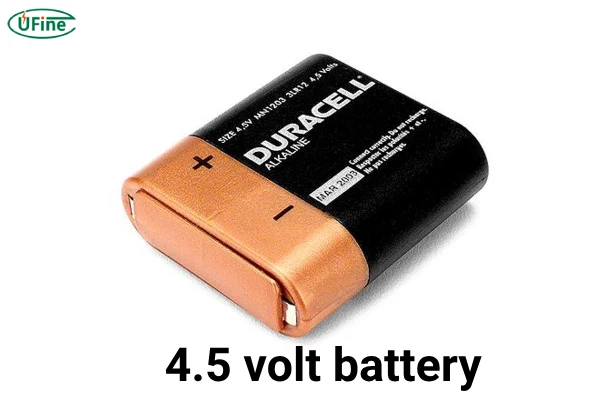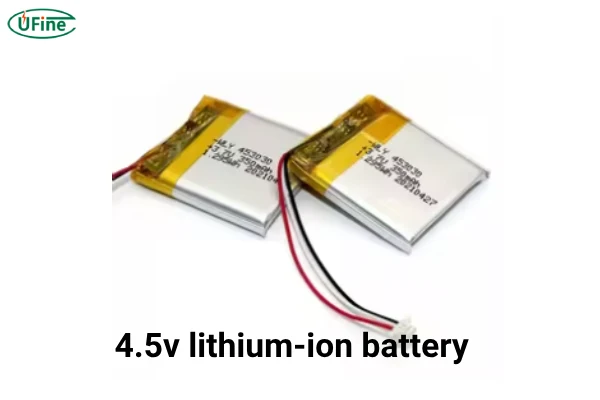You’ve probably seen a 4.5-volt battery before—maybe in a toy, a flashlight, or a clock. But how much do you really know about it? A 4.5-volt battery may seem like a small part of the vast battery world, but it plays a crucial role in many devices we use every day. Understanding the ins and outs of 4.5V batteries can help you choose the right one for your needs, extend their lifespan, and make sure your devices are powered effectively.
In this article, we’ll break down everything you need to know about 4.5-volt batteries. We’ll cover the types, sizes, and shapes, and explore whether they’re rechargeable or not. You’ll also learn where they’re used, how much they typically cost, and how long they last. Whether you’re a DIY enthusiast, a parent looking for batteries for toys, or just someone curious about batteries, this guide is for you.
Part 1. Types of 4.5 volt battery

The 4.5-volt battery market isn’t a one-size-fits-all scenario. There are several different types of 4.5V batteries, each suited for specific applications and offering distinct advantages. Let’s explore them.
-
Alkaline 4.5V Batteries:
Alkaline batteries are probably the most common type of 4.5V battery. They are non-rechargeable, and you’ll find them in many devices that require steady, long-lasting power. Alkaline batteries work well in low-drain devices, meaning they can last for a long time when powering things like clocks, remote controls, or certain toys. While not the most eco-friendly, they are widely available and affordable, making them a go-to choice for many. -
Lithium 4.5V Batteries:
Lithium batteries, though more expensive, offer a significant performance boost. These batteries are known for their long lifespan, high energy density, and lightweight design. Unlike alkaline batteries, lithium batteries can hold a charge for extended periods without significant degradation. This makes them an ideal choice for high-performance or cold-weather devices. If you’re using a 4.5V battery in a critical device (such as medical equipment) or something that needs to run for long periods without being replaced, a lithium battery might be the best option. -
Nickel-Metal Hydride (NiMH) 4.5V Batteries:
NiMH batteries are rechargeable and offer a good balance between performance and sustainability. Although they don’t quite match lithium-ion batteries in terms of energy density, they are an excellent choice if you want to save money and reduce waste in the long run. With a shorter lifespan compared to lithium batteries, NiMH batteries still offer good value, especially in applications where you don’t need the extreme performance of lithium-ion cells. -
Carbon-Zinc 4.5V Batteries:
Carbon-zinc batteries are generally less expensive than other types but come with a trade-off in performance. These batteries are often used in low-drain devices, such as toys or small gadgets, where cost is more important than long-term reliability. They’re not rechargeable, and their lifespan is shorter compared to alkaline or lithium options. Despite this, they’re widely available and provide basic power for less demanding uses.
Part 2. 4.5 volt battery size and shape
When it comes to the size and shape of 4.5-volt batteries, there’s a variety of options, depending on the battery type and the specific device it’s powering. The shape of the battery is often designed to fit specific devices, which is why it’s important to make sure you get the right one.
-
Flat Pack Design:
Many 4.5V batteries, especially the ones used in devices like flashlights and small electronic toys, come in a flat, rectangular shape. These batteries typically consist of three 1.5V cells connected in series to create the required voltage. This format is ideal for devices where a compact and thin battery is necessary. -
Square or Rectangular Block:
In some cases, 4.5V batteries are available in a squarer or block-like format. This shape is often used in larger, more rugged devices, including some medical instruments and specialty equipment.
The size of the battery is important to ensure it fits in the designated compartment. For example, a toy might need a flat pack design, while a flashlight could require a block-style battery. Double-check your device’s battery compartment size to avoid compatibility issues.
Part 3. Is the 4.5 volt battery rechargeable?
The short answer is: it depends on the type of battery.
-
Non-Rechargeable:
Alkaline and carbon-zinc 4.5V batteries are typically non-rechargeable. Once these batteries lose their charge, you must replace them. While these types are more affordable upfront, they can become expensive over time if used frequently. -
Rechargeable Options:
NiMH 4.5V batteries are rechargeable, which can save you money in the long term. If you use a device that demands a lot of power or you find yourself replacing batteries often, opting for a rechargeable NiMH battery is a more sustainable option.
Lithium 4.5V batteries can also be rechargeable, although this is less common. If you need the extra power and longevity that lithium provides, a rechargeable lithium-ion 4.5V battery can be a great option.
If you’re unsure, check the packaging or product description for a clear indication of whether the battery is rechargeable.
Rechargeable LiPo Battery vs. Non-Rechargeable Battery
Part 4. What is a 4.5 volt battery pack?
A 4.5V battery pack is simply a group of individual cells connected together to provide a total voltage of 4.5 volts. Most commonly, a 4.5V battery pack consists of three 1.5V cells connected in series. These battery packs are used in devices that need more energy but require a compact form factor, such as portable medical equipment or small electronic tools.
A battery pack can offer more flexibility in certain applications, as it can be built with specific chemistries to match the needs of the device, whether it’s an alkaline, lithium, or NiMH setup. This combination of multiple cells helps ensure the battery pack provides the necessary power to run the device without constantly swapping individual cells.
Part 5. Is a 4.5v lithium-ion battery the best 4.5 volt battery?
When it comes to choosing the best 4.5V battery, lithium-ion often stands out as one of the top contenders. But is it the best for every use? Let’s take a closer look.
- Advantages of Lithium-Ion 4.5V Batteries:
- Longer Lifespan: Lithium-ion batteries are known for their long lifespan. They can last up to 2-3 times longer than alkaline batteries, depending on the usage.
- Consistent Voltage: Unlike some other battery types that lose voltage as they drain, lithium-ion batteries maintain a steady output until they are almost completely depleted.
- Lightweight and Compact: These batteries are lighter and more compact, which is perfect for devices where weight and size matter.
- High Energy Density: Lithium-ion batteries pack more power into a smaller space, making them ideal for devices that require consistent and reliable performance over time.
However, lithium-ion batteries are typically more expensive than their non-rechargeable counterparts. So, if you’re using a device that doesn’t demand such high performance, you may not need to opt for a lithium-ion 4.5V battery.
For everyday devices, an alkaline or carbon-zinc battery may suffice. But for gadgets that need more consistent power, a lithium-ion 4.5V battery will be a worthwhile investment.
Part 6. Where is a 4.5 volt battery used?
4.5V batteries are more common than you might think, and they are used in a wide range of devices. Some of the most common applications include:
-
Toys: Many toys, particularly older models, rely on 4.5V batteries. These batteries are perfect for low-drain toys that need to run for long periods without frequent battery replacements.
-
Clocks: If you’ve ever noticed a clock that uses 4.5V batteries, this is because they provide steady, reliable power. Many wall clocks, alarm clocks, and other timepieces rely on this type of battery.
-
Flashlights: Compact flashlights often use 4.5V batteries, providing just the right amount of power for portability and brightness without being overly bulky.
-
Medical Devices: Certain portable medical equipment, such as hearing aids or blood glucose meters, use 4.5V batteries for long-lasting power and reliability.
-
Remote Controls: Some types of remotes for garage doors or even certain car key fobs utilize 4.5V batteries for operation.
-
Musical Instruments: Some small musical instruments like keyboards or electronic drum pads use 4.5V batteries, especially in portable models.
These are just a few examples, and 4.5V batteries can be found in many more gadgets that need long-lasting, low-power energy.
Part 7. Price
The price of a 4.5V battery can vary depending on the type, brand, and where you purchase it. As a general guideline:
-
Alkaline 4.5V Batteries: These are the most affordable, typically costing between $1 and $5 each.
-
Lithium 4.5V Batteries: These tend to be more expensive, ranging from $5 to $15 per battery, depending on the brand and whether they’re rechargeable.
-
NiMH Rechargeable 4.5V Batteries: These typically cost between $7 and $20 for a pack, though the long-term savings from recharging can make them more cost-effective over time.
Part 8. How long do 4.5 volt batteries last?
The lifespan of a 4.5V battery depends on several factors, including the battery type, the device it powers, and how frequently it’s used. Here’s a rough idea:
-
Alkaline Batteries: Typically last 1 to 3 years in low-drain devices like clocks and remotes. However, they may last only a few months in high-drain devices like toys.
-
Lithium Batteries: These can last anywhere from 3 to 10 years, depending on the application. They’re ideal for devices that require consistent power over extended periods.
-
NiMH Rechargeable Batteries: NiMH batteries typically last 500 to 1,000 charge cycles. Their lifespan in a single device will vary, but with proper care, they can be recharged hundreds of times.
Part 9. Final words
The 4.5-volt battery may not be the first one that comes to mind when you think of power, but it’s essential in many of our daily devices. From toys to medical equipment, these batteries provide steady and reliable energy for everything from simple gadgets to high-performance devices. Understanding the different types, their lifespan, and where they’re used helps ensure you’re choosing the right battery for your needs.
Whether you’re looking for a cost-effective alkaline battery or a more powerful, long-lasting lithium-ion option, you now have all the information you need to make an informed choice. Remember, each device has its own power requirements, so always check the specifications to make sure you’re using the right type of 4.5V battery.
Related Tags:
More Articles

How to Choose the Best Floor Scrubber Battery for Commercial Cleaning?
Selecting the ideal floor scrubber battery ensures a long runtime, rapid charging, and minimal maintenance for efficient commercial cleaning operations.
Battery for Blower vs Battery for Leaf Vacuum: Which One Should You Choose?
Battery for blower vs leaf vacuum—learn the key differences in power, fit, and runtime to choose the right battery for your outdoor tool needs.
How to Choose the Right Battery for Blower?
Choosing the right blower battery? Consider voltage, capacity, chemistry & usage. This guide helps match the best battery for peak performance.
How to Choose the Best Insulated Battery Box for Lithium Batteries?
Choosing the Best Insulated Battery Box for Lithium Batteries? Discover key factors such as size, material, and safety for optimal protection and performance.
7 Critical Elements on a Lithium Battery Shipping Label
What must be on a lithium battery shipping label? Learn 7 key elements to ensure safety, legal compliance, and correct handling across all transport modes.




